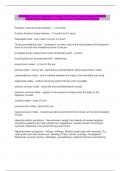NUR3066C Exam 2 | Questions & Answers (100 %Score) Latest Updated 2024/2025
Comprehensive Questions A+ Graded Answers | With Expert Solutions
Posterior fontanel closes between - 1-2 months
Anterior fontanel closes between - 9 months and 2 years
Nasolabial folds - from nose to corner of mouth
Temporomandibular Joint - connection on either side of the head between the temporal
bone of the skull and mandibular bone of the jaw
to palpate lymph nodes what motion should be used? - circular
thyroid gland can be assessed with - swallowing
preauricular nodes - in front of the ear
parotid nodes - front of ear, superficial to parotid gland, below preauricular nodes
submandibular nodes - found halfway between the angle of the mandible and its tip
submental nodes - midline structures behind the tip of the mandible
anterior cervical nodes - along the sternocleidomastoid muscle
posterior cervical nodes - appear in the posterior triangle along the edge of the
trapezius muscle.
occipital nodes - base of skull
postauricular nodes - behind the ear
supraclavicular nodes - located just above and behind the clavicle, at the sternomastoid
muscle
Hyperthyroidism symptoms - Nervousness, weight loss despite increased appetite,
excessive sweating and heat intolerance, palpitations, frequent bowel movements,
muscular weakness of the proximal type and tremor
Hypothyroidism symptoms - Fatigue, lethargy. Modest weight gain with anorexia. Dry,
coarse skin and cold intolerance. Swelling of face, hands, and legs. Constipation.
Weakness, muscle cramps, arthralgias, paresthesias, impaired memory and hearing.
,Snellen chart - chart used for testing visual acuity; contains letters of varying sizes and
is shown from a distance of 20 ft; avg person who can read at this distance is said to
have 20/20 vision
20/20 vision means - that you can see objects at 20 feet that individuals with normal
eyesight can see at 20 feet
snellen chart tests - far vision
Snellen chart test - -Stand 20 ft from chart
- Cover one eye at a time
- Allowed to miss 2 letters. More than that, move to the larger font.
Rosenbaum chart - used to assess near vision acuity
Rosenbaum chart distance - 14 inch
confrontation test - - Have patient cover one eye
- Position self at eye level
- Test from periphery inward with wiggling finger
- Patient should see it in the same field of vision as the examiner
Extraocular muscle function (EOM's) - six cardinal positions of gaze
conjuctiva - mucous membrane that lines the eyelids and outer surface of the eyeball
Sclera - white of the eye
red reflex - red glow that appears to fill the person's pupil when first visualized through
the ophthalmoscope
ptosis - drooping of eyelid (one side, cranial nerve 7)
cataracts - clouding of the lens
conjuctivitis - inflammation/infection of the conjunctiva (viral, bacterial, allergies)
strabismus - crossed eyes
tympanic membrane location - anterior inferior quadrant (5 oclock in right ear and 7
oclock in left)
webber test - Tunning fork on midline of skull, pt idenities sound that is loudest, normal
hearing sound is heard equally, sound louder in ear with hearing loss, softer in ear with
sensorineural hearing loss.
, conductive hearing loss - hearing impairment caused by interference with sound or
vibratory energy in the external canal, middle ear, or ossicles
Rinne test - hearing acuity test performed with a vibrating tuning fork that is first placed
on the mastoid process and then in front of the external auditory canal to test bone and
air conduction
Rinne positive test - sound heard longer through air connection than bone connection
rinne negative test - sound heard longer through bone connection than air connection
sensoryneural hearing loss - hearing loss caused by damage to the cochlea's receptor
cells or to the auditory nerves; also called nerve deafness
Rinne test evaluates - sensoryneural hearing loss
dysphagia - difficulty swallowing
tonsil grades - 0 tonsils removed
1+ barely isible
2+ halfway between tonsillar pillars and uvula (normal)
3+ almost touching the uvula
4+ touching uvula/each other
precordium - area of the chest wall overlying the heart and great vessels
Pregnant woman peripheral vascular changes - - Expect diffuse bilateral pitting edema
in the lower extremities especially at the end of the day
- varicose neins
Peripheral blood vessels with age - grow more rigid with age, resulting in
arteriosclerosis with increased prevalence of peripheral arterial disease (PAD)
Intermittent claudication(vascular claudication) - a symptom that describes muscle pain
on mild exertion (ache, cramp, numbness or sense of fatigue), classically in the calf
muscle, which occurs during exercise, such as walking, and is relieved by a short period
of rest.
deep vein thrombosis (DVT) and subsequent pulmonary embolism (PE) can result from
- prolonged bed rest, immobilization and heart failure
what to inspect for on arms & hands bilaterally - symmetry, edema (swelling), skin
temperature, color, movement, sensation (parethesia=numbness & tingling)
normal cap refill - less than 2 sec- dehydration if more than 2, alarming if more than 3




